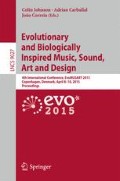Abstract
Aiming for high-level intentional control of audio feedback, though microphones, loudspeakers and digital signal processing, we present a system adapting toward chosen sonic features. Users control the system by selecting and changing feature objectives in real-time. The system has a second-order structure in which the internal signal processing algorithms are developed according to an evolutionary process. Genotypes develop into signal-processing algorithms, and fitness is measured by analysis of the incoming audio feedback. A prototype is evaluated experimentally to measure changes of audio feedback depending on the chosen target conditions. By enhancing interactivity of an audio feedback through the intentional control, we expect that feedback systems could be utilized more effectively in the fields of musical interaction, finding balance between nonlinearity and interactivity.
Access this chapter
Tax calculation will be finalised at checkout
Purchases are for personal use only
References
Di Scipio, A.: ‘Sound is the interface’: from interactive to ecosystemic signal processing. Organised Sound 8(3), 269–277 (2004)
Kim, S., Yeo, W.S.: Musical control of a pipe based on acoustic resonance. In: Proceedings of the Internation Conference on New Interfaces for Musical Expression, pp. 217–219 (2011)
Kim, S., Yeo, W.S.: Electronic pipe organ using audio feedback. In: Proceedings of the Sound and Music Computing, pp. 75–78 (2012)
Kollias, P.A.: Ephemeron: control of self-organised music. Hz Music J. 14, 138–146 (2009)
Sanfilippo, D.: Turning perturbation into emergent sound, and sound into perturbation, pp. 1–16 (2013). interferencejournal.com
Di Scipio, A.: Listening to yourself through the otherself: on background noise study and other works. Organised Sound 16(2), 97–108 (2011)
Mitchell, M.: Complex systems: network thinking. Artif. Intell. 170(18), 1194–1212 (2006)
Kollias, P.A.: The self-organising work of music. Organised Sound 16(2), 192–199 (2011)
Heylighen, F., Joslyn, C.: Cybernetics and second order cybernetics. Encycl. Phys. Sci. Technol. 4, 155–170 (2001)
Murray-Rust, D., Smaill, A., Maya, M.C.: VirtuaLatin-towards a musical multi-agent system. In: Proceedings of the International Conference on Computational Intelligence and Multimedia Applications, pp. 17–22 (2005)
Wulfhorst, R.D., Nakayama, L., Vicari, R.M.: A multiagent approach for musical interactive systems. In: Proceedings of the Second International Joint Conference on Autonomous Agents and Multiagent Systems, pp. 584–591 (2003)
Van Nort, D., Braasch, J., Oliveros, P.: A system for musical improvisation combining sonic gesture recognition and genetic algorithms. In: Proceedings of the 6th Sound and Music Computing Conference, pp. 131–136 (2009)
Hsu, W.: Strategies for managing timbre and interaction in automatic improvisation systems. Leonardo Music J. 20, 33–39 (2010)
Ciufo, T.: Beginner’s mind: an environment for sonic improvisation. In: Proceedings of the International Computer Music Conference, pp. 781–784 (2005)
De Cheveigné, A., Kawahara, H.: Yin, a fundamental frequency estimator for speech and music. J. Acoust. Soc. Am. 111(4), 1917–1930 (2002)
Bown, O.: Experiments in modular design for the creative composition of live algorithms. Comput. Music J. 35(3), 73–85 (2011)
Blackwell, T., Young, M.: Self-organised music. Organised Sound 9(2), 123–136 (2004)
Neuman, I.: Generative tools for interactive composition: real-time musical structures based on schaeffer’s tartyp and on klumpenhouwer networks. Comput. Music J. 38(2), 63–77 (2014)
Dahlstedt, P.: A mutasynth in parameter space: interactive composition through evolution. Organised Sound 6(2), 121–124 (2001)
Bown, O., Lexer, S.: Continuous-time recurrent neural networks for generative and interactive musical performance. In: Rothlauf, F., Branke, J., Cagnoni, S., Costa, E., Cotta, C., Drechsler, R., Lutton, E., Machado, P., Moore, J.H., Romero, J., Smith, G.D., Squillero, G., Takagi, H. (eds.) EvoWorkshops 2006. LNCS, vol. 3907, pp. 652–663. Springer, Heidelberg (2006)
Griffiths, D.: Fastbreeder
Scamarcio, M.: Space as an evolution strategy: Sketch of a generative ecosystemic structure of sound. In: Proceedings of the Sound and Music Computing Conference, pp. 95–99 (2008)
Biles, J.: GenJam: a genetic algorithm for generating jazz solos. In: Proceedings of the International Computer Music Conference, pp. 131–131 (1994)
Biles, J.A.: Evolutionary computation for musical tasks. In: Miranda, E.R., Biles, J.A. (eds.) Evolutionary Computer Music, pp. 28–51. Springer, London (2007)
Acknowledgments
This work was supported by the BK21 plus program through the National Research Foundation (NRF) funded by the Ministry of Education of Korea.
Author information
Authors and Affiliations
Corresponding author
Editor information
Editors and Affiliations
Rights and permissions
Copyright information
© 2015 Springer International Publishing Switzerland
About this paper
Cite this paper
Kim, S., Nam, J., Wakefield, G. (2015). Toward Certain Sonic Properties of an Audio Feedback System by Evolutionary Control of Second-Order Structures. In: Johnson, C., Carballal, A., Correia, J. (eds) Evolutionary and Biologically Inspired Music, Sound, Art and Design. EvoMUSART 2015. Lecture Notes in Computer Science(), vol 9027. Springer, Cham. https://doi.org/10.1007/978-3-319-16498-4_11
Download citation
DOI: https://doi.org/10.1007/978-3-319-16498-4_11
Published:
Publisher Name: Springer, Cham
Print ISBN: 978-3-319-16497-7
Online ISBN: 978-3-319-16498-4
eBook Packages: Computer ScienceComputer Science (R0)

